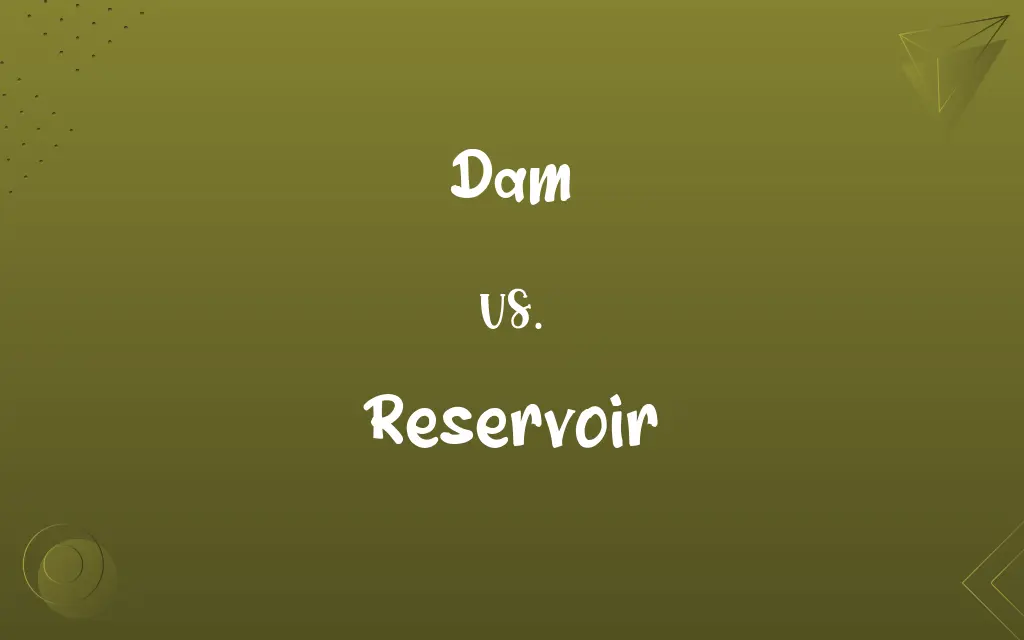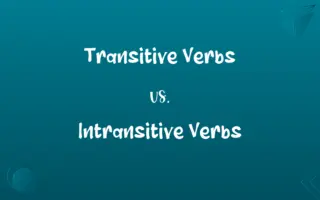Dam vs. Reservoir: Know the Difference
A dam is a barrier constructed to hold back water and raise its level, forming a reservoir, which is a storage space for water.

Key Differences
A dam is a physical barrier, often made of concrete or earth, built across a river or stream to control the flow of water. In contrast, a reservoir is the area behind the dam that stores water. While the dam serves as a means of control and diversion, the reservoir acts as a storage unit.
The primary function of a dam is to retain water, whereas a reservoir is specifically designed to store water. Dams are engineered structures, emphasizing strength and durability. Reservoirs, on the other hand, are the result of damming a water source and can vary in size and shape.
Maintenance of a dam focuses on structural integrity and safety, addressing concerns like water pressure and material erosion. For a reservoir, the emphasis is on water quality and ecosystem management, ensuring the stored water remains usable and the environment balanced.
In terms of environmental impact, the construction of a dam can significantly alter the local ecosystem and hydrology. Conversely, a reservoir can create new habitats and recreational areas, although it also can lead to environmental and ecological changes.
Finally, while both dams and reservoirs are crucial for water management, their roles differ. Dams are key in flood control, hydroelectric power generation, and irrigation. Reservoirs are important for water supply, recreational purposes, and sometimes as fish habitats.
ADVERTISEMENT
Comparison Chart
Definition
A structure built to restrict and control water flow.
A storage area for water, usually formed by a dam.
Purpose
Primarily for controlling water flow and storage.
Mainly for storing water for various uses.
Construction Material
Made of concrete, steel, or earth.
Formed by water collected behind a dam.
Impact on Environment
Can significantly alter river flow and ecosystems.
Can create new habitats but may also affect ecosystems.
Associated Activities
Often related to power generation and flood control.
Usually linked with water supply and recreation.
ADVERTISEMENT
Dam and Reservoir Definitions
Dam
A dam is a structure built across a river to control the river's flow or create a reservoir.
The Three Gorges Dam in China is the world's largest hydroelectric power station.
Reservoir
A reservoir can also mean a large or extra supply of something.
The library was a reservoir of knowledge.
Dam
In an informal context, 'dam' means to block or hold back something.
He tried to dam his feelings of anger during the meeting.
Reservoir
In medicine, a reservoir refers to a host of an infectious pathogen.
The stagnant pond became a reservoir for mosquitoes.
Dam
A barrier constructed across a waterway to control the flow or raise the level of water.
ADVERTISEMENT
Reservoir
A natural or artificial pond or lake used for the storage and regulation of water.
Dam
A body of water controlled by such a barrier.
Reservoir
A receptacle or chamber for storing a fluid.
Dam
A barrier against the passage of liquid or loose material, as a rubber sheet used in dentistry to isolate one or more teeth from the rest of the mouth.
Reservoir
An underground accumulation of petroleum or natural gas.
Dam
A female parent of an animal, especially a domesticated mammal such as a horse.
Reservoir
(Anatomy) See cisterna.
Dam
(Archaic) A mother.
Reservoir
A large or extra supply; a reserve
A reservoir of goodwill.
Dam
To hold back or confine by means of a dam.
Reservoir
(Medicine) An organism or population that directly or indirectly transmits a pathogen while being virtually immune to its effects.
Dam
To close up; obstruct
He tried to dam his grief.
Reservoir
A place where anything is kept in store.
Dam
A structure placed across a flowing body of water to stop the flow or part of the flow, generally for purposes such as retaining or diverting some of the water or retarding the release of accumulated water to avoid abrupt flooding.
A dam is often an essential source of water to farmers of hilly country.
Reservoir
A large natural or artificial lake used as a source of water supply.
Dam
The water reservoir resulting from placing such a structure.
Boats may only be used at places set aside for boating on the dam.
Reservoir
A small intercellular space, often containing resin, essential oil, or some other secreted matter.
Dam
(dentistry) A device to prevent a tooth from getting wet during dental work, consisting of a rubber sheet held with a band.
Reservoir
A supply or source of something.
Dam
A reservoir.
Reservoir
A species that acts as host to a zoonosis when it is not causing acute illness in other susceptible species.
Dam
A firebrick wall, or a stone, which forms the front of the hearth of a blast furnace.
Reservoir
(computing) A "black box" component that receives an input signal to be read out and mapped by another process, as part of reservoir computing.
Dam
Female parent, mother, generally regarding breeding of animals.
Reservoir
(transitive) To store or keep (something) in or as in a reservoir.
Dam
A kind of crowned piece in the game of draughts.
Reservoir
A place where anything is kept in store; especially, a place where water is collected and kept for use when wanted, as to supply a fountain, a canal, or a city by means of aqueducts, or to drive a mill wheel, or the like.
Dam
(India) An obsolete Indian copper coin, equal to a fortieth of a rupee.
Reservoir
A small intercellular space, often containing resin, essential oil, or some other secreted matter.
Dam
A former coin of Nepal, 128 of which were worth one mohar.
Reservoir
A large quantity of infectious microorganisms resident in animals other than man, potentially capable of being transmitted to humans.
Dam
(transitive) To block the flow of water.
Reservoir
A large quantity of infectious microorganisms or parasites resident in animals other than man, potentially capable of being transmitted to humans; especially, such organisms in animals where they do little or no harm to the host.
Dam
Damn.
Reservoir
A large supply or stock of anything which may be rapidly put to use; a reserve.
Dam
Damn.
Reservoir
A large or extra supply of something;
A reservoir of talent
Dam
A female parent; - used of beasts, especially of quadrupeds; sometimes applied in contempt to a human mother.
Our sire and dam, now confined to horses, are a relic of this age (13th century) . . . .Dame is used of a hen; we now make a great difference between dame and dam.
The dam runs lowing up and down,Looking the way her harmless young one went.
Reservoir
Lake used to store water for community use
Dam
A king or crowned piece in the game of draughts.
Reservoir
Tank used for collecting and storing a liquid (as water or oil)
Dam
A barrier to prevent the flow of a liquid; esp., a bank of earth, or wall of any kind, as of masonry or wood, built across a water course, to confine and keep back flowing water.
Reservoir
Anything (a person or animal or plant or substance) in which an infectious agent normally lives and multiplies;
An infectious agent depends on a reservoir for its survival
Dam
A firebrick wall, or a stone, which forms the front of the hearth of a blast furnace.
Reservoir
A reservoir is a natural or artificial lake used as a source of water supply.
The city's main water supply comes from a nearby reservoir.
Dam
To obstruct or restrain the flow of, by a dam; to confine by constructing a dam, as a stream of water; - generally used with in or up.
I'll have the current in this place dammed up.
A weight of earth that dams in the water.
Reservoir
A reservoir is a place where fluid collects, especially within a natural or artificial lake.
The mountain reservoir stores rainwater during the wet season.
Dam
To shut up; to stop up; to close; to restrain.
The strait pass was dammedWith dead men hurt behind, and cowards.
Reservoir
A reservoir can be a receptacle or chamber for holding a liquid or fluid.
The car's coolant reservoir needed to be refilled.
Dam
A barrier constructed to contain the flow of water or to keep out the sea
Dam
A metric unit of length equal to ten meters
Dam
Female parent of an animal especially domestic livestock
Dam
Obstruct with, or as if with, a dam;
Dam the gorges of the Yangtse River
Dam
A dam is a barrier that stops or restricts the flow of water or underground streams.
The Hoover Dam controls the flow of the Colorado River.
Dam
In construction, a dam is a barrier to confine or exclude water.
They built a temporary dam to divert the river during the bridge construction.
Dam
A dam can also refer to a barrier preventing the spread of liquid, sand, or other material.
Sandbags were used as a dam to prevent the floodwaters from entering the house.
Repeatedly Asked Queries
What is a reservoir?
A reservoir is a large natural or artificial lake used for water storage.
How do reservoirs benefit wildlife?
Reservoirs can create new habitats for various aquatic and bird species.
What is the primary function of a reservoir?
The primary function of a reservoir is to store water for various uses like drinking, irrigation, and industry.
What is a dam?
A dam is a structure built to block the flow of water in a river or stream.
What are the main purposes of a dam?
Dams are used for water supply, electricity generation, irrigation, and flood control.
Are reservoirs always man-made?
No, some reservoirs are natural, while others are man-made.
Do reservoirs affect local climate?
Large reservoirs can have a microclimate effect, sometimes increasing local humidity.
How do dams help in creating reservoirs?
Dams block rivers, creating reservoirs by accumulating the backed-up water.
Can reservoirs exist without dams?
Yes, some reservoirs are natural basins or lakes without dams.
Do all dams create reservoirs?
Most dams create reservoirs, but some smaller dams may not hold enough water to form a significant reservoir.
What is a gravity dam?
A gravity dam is a type of dam that relies on its weight to hold back water.
What are the environmental impacts of dams?
Dams can disrupt local ecosystems, affect fish migration, and change sediment patterns.
Can reservoirs be used for recreation?
Yes, many reservoirs are popular spots for fishing, boating, and swimming.
How long can a dam last?
Well-maintained dams can last over a century, but they require ongoing care and possible upgrades.
Are there any alternatives to dams for water storage?
Alternatives include groundwater recharge, aquifer storage, and smaller-scale water collection systems.
How are dams maintained?
Dams require regular inspections, repairs, and monitoring to ensure their safety and functionality.
How do dams generate electricity?
Many dams generate electricity using turbines turned by the flow of water released from the reservoir.
What are the risks associated with dams?
Dams can pose risks like structural failure, flooding, and ecological disruption.
What is an embankment dam?
An embankment dam is made from compacted earth or rock and is one of the most common dam types.
Can reservoirs run dry?
Yes, reservoirs can run dry due to drought, overuse, or poor management.
Share this page
Link for your blog / website
HTML
Link to share via messenger









































































